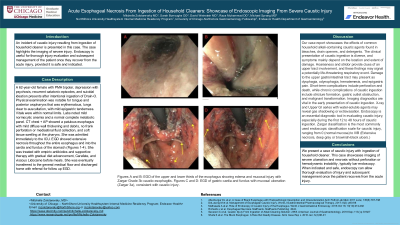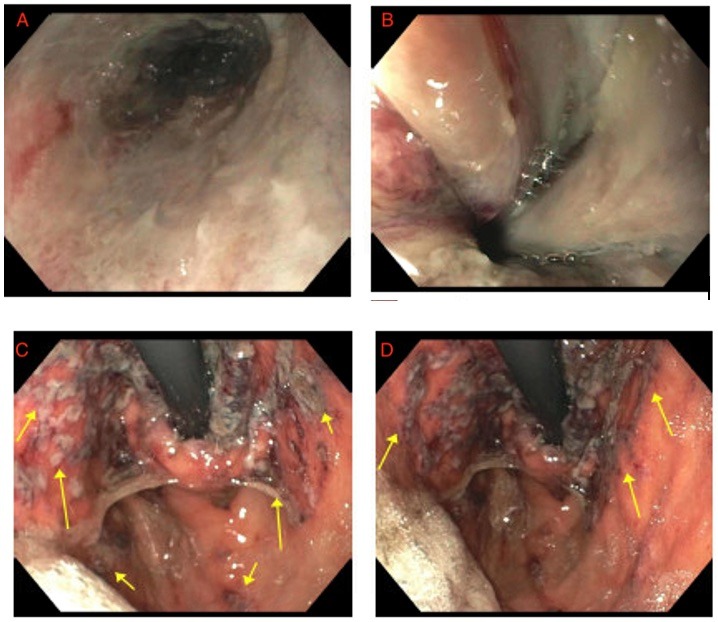Monday Poster Session
Category: Esophagus
P2321 - Acute Esophageal Necrosis From Ingestion of Household Cleaners: Showcase of Endoscopic Imaging From Severe Caustic Injury
Monday, October 28, 2024
10:30 AM - 4:00 PM ET
Location: Exhibit Hall E

Has Audio

Mitchelle V. Zolotarevsky, MD
University of Chicago, NorthShore Internal Medicine
Chicago, IL
Presenting Author(s)
Mitchelle V. Zolotarevsky, MD1, Sarah Burroughs, DO2, David Weinstein, MD3, Raza Muhammad, DO4, Michael Sprang, MD5
1University of Chicago, NorthShore Internal Medicine, Chicago, IL; 2University of Chicago, Northshore University Healthsystem, Evanston, IL; 3University of Chicago, NorthShore Internal Medicine, Evanston, IL; 4University of Chicago Endeavor Health, Evanston, IL; 5NorthShore University HealthSystem, Evanston, IL
Introduction: An incident of caustic injury resulting from the ingestion of household cleaners is presented in this case. The case highlights the imaging of severe injury. Endoscopy is essential for the evaluation and subsequent management of caustic injury.
Case Description/Methods: A 62-year-old female with PMH bipolar, depression with psychosis, recurrent catatonic episodes, and suicidal ideation presents after an intentional ingestion of a household cleaner. Physical examination was notable for tongue and posterior oropharynx erythematous, clear lungs to auscultation, with mild epigastric tenderness. Vitals were within normal limits. Labs noted mild normocytic anemia and a normal complete metabolic panel. CT chest + AP showed a patulous esophagus with mild diffuse wall thickening and debris, no frank perforation or mediastinal fluid collection, and soft tissue swelling at the pharynx (Figures 1-2). She was admitted immediately to the ICU. EGD showed extensive necrosis throughout the entire esophagus and into the cardia and fundus of the stomach (Figures 3-4). She was treated with empiric antibiotics and supportive therapy with gradual diet advancement, Carafate, and viscous Lidocaine before meals. She was eventually transferred to the general medical floor and discharged home.
Discussion: Our case report showcases the effects of common household alkali-containing caustic agents found in bleaches, drain openers, and detergents. The clinical presentation of caustic ingestion is diverse, and symptoms mainly depend on the location and extent of damage. Hoarseness and stridor provide clues of an upper tract involvement, and these findings may signal a potentially life-threatening respiratory event. Damage to the upper gastrointestinal tract may present as dysphagia, odynophagia, hematemesis, and epigastric pain. Short-term complications include perforation and death, while chronic complications of caustic ingestion include stricture formation, gastric outlet obstruction, and malignant transformation. Imaging diagnostics are vital in the early presentation of caustic ingestion. X-ray and Upper GI series with water-soluble agents may reveal gas shadowing or extravasation. Endoscopy is an essential diagnostic tool in evaluating caustic injury, especially during the first 12 to 48 hours of caustic ingestion. Zargar classification is the most commonly used endoscopic classification scale for caustic injury, ranging from 0 (normal mucosa) to IIIB (Extensive necrosis, deep gray or brownish-black ulcers.)

Disclosures:
Mitchelle V. Zolotarevsky, MD1, Sarah Burroughs, DO2, David Weinstein, MD3, Raza Muhammad, DO4, Michael Sprang, MD5. P2321 - Acute Esophageal Necrosis From Ingestion of Household Cleaners: Showcase of Endoscopic Imaging From Severe Caustic Injury, ACG 2024 Annual Scientific Meeting Abstracts. Philadelphia, PA: American College of Gastroenterology.
1University of Chicago, NorthShore Internal Medicine, Chicago, IL; 2University of Chicago, Northshore University Healthsystem, Evanston, IL; 3University of Chicago, NorthShore Internal Medicine, Evanston, IL; 4University of Chicago Endeavor Health, Evanston, IL; 5NorthShore University HealthSystem, Evanston, IL
Introduction: An incident of caustic injury resulting from the ingestion of household cleaners is presented in this case. The case highlights the imaging of severe injury. Endoscopy is essential for the evaluation and subsequent management of caustic injury.
Case Description/Methods: A 62-year-old female with PMH bipolar, depression with psychosis, recurrent catatonic episodes, and suicidal ideation presents after an intentional ingestion of a household cleaner. Physical examination was notable for tongue and posterior oropharynx erythematous, clear lungs to auscultation, with mild epigastric tenderness. Vitals were within normal limits. Labs noted mild normocytic anemia and a normal complete metabolic panel. CT chest + AP showed a patulous esophagus with mild diffuse wall thickening and debris, no frank perforation or mediastinal fluid collection, and soft tissue swelling at the pharynx (Figures 1-2). She was admitted immediately to the ICU. EGD showed extensive necrosis throughout the entire esophagus and into the cardia and fundus of the stomach (Figures 3-4). She was treated with empiric antibiotics and supportive therapy with gradual diet advancement, Carafate, and viscous Lidocaine before meals. She was eventually transferred to the general medical floor and discharged home.
Discussion: Our case report showcases the effects of common household alkali-containing caustic agents found in bleaches, drain openers, and detergents. The clinical presentation of caustic ingestion is diverse, and symptoms mainly depend on the location and extent of damage. Hoarseness and stridor provide clues of an upper tract involvement, and these findings may signal a potentially life-threatening respiratory event. Damage to the upper gastrointestinal tract may present as dysphagia, odynophagia, hematemesis, and epigastric pain. Short-term complications include perforation and death, while chronic complications of caustic ingestion include stricture formation, gastric outlet obstruction, and malignant transformation. Imaging diagnostics are vital in the early presentation of caustic ingestion. X-ray and Upper GI series with water-soluble agents may reveal gas shadowing or extravasation. Endoscopy is an essential diagnostic tool in evaluating caustic injury, especially during the first 12 to 48 hours of caustic ingestion. Zargar classification is the most commonly used endoscopic classification scale for caustic injury, ranging from 0 (normal mucosa) to IIIB (Extensive necrosis, deep gray or brownish-black ulcers.)

Figure: Figures A and B: EGD of the upper and lower thirds of the esophagus showing edema and mucosal injury with Zargar Grade 3b caustic esophagitis.
Figures C and D: EGD of gastric cardia and fundus with mucosal ulceration (Zargar 3a), consistent with caustic injury.
Figures C and D: EGD of gastric cardia and fundus with mucosal ulceration (Zargar 3a), consistent with caustic injury.
Disclosures:
Mitchelle Zolotarevsky indicated no relevant financial relationships.
Sarah Burroughs indicated no relevant financial relationships.
David Weinstein indicated no relevant financial relationships.
Raza Muhammad indicated no relevant financial relationships.
Michael Sprang indicated no relevant financial relationships.
Mitchelle V. Zolotarevsky, MD1, Sarah Burroughs, DO2, David Weinstein, MD3, Raza Muhammad, DO4, Michael Sprang, MD5. P2321 - Acute Esophageal Necrosis From Ingestion of Household Cleaners: Showcase of Endoscopic Imaging From Severe Caustic Injury, ACG 2024 Annual Scientific Meeting Abstracts. Philadelphia, PA: American College of Gastroenterology.
